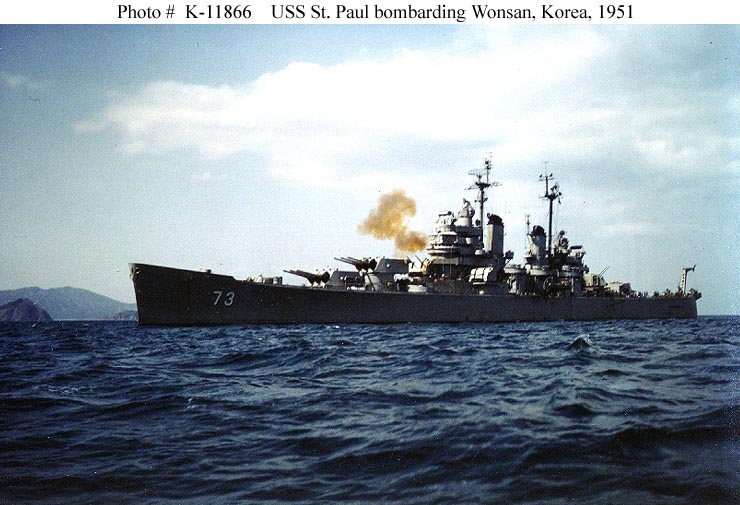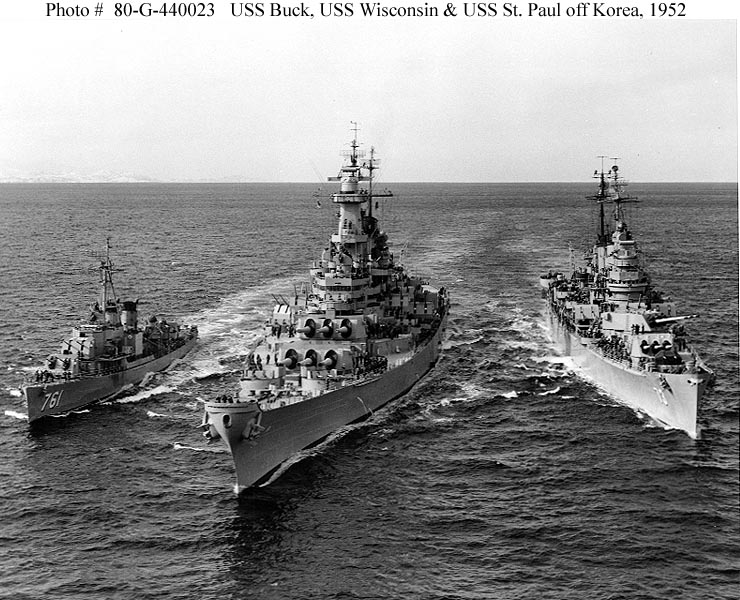(She) reported to Admiral "Bull" Halsey's Third Fleet and participated in task force strikes on the Japanese mainland near the close of World War II. On August 9, 1945, she fired the final salvo on the home islands of Japan. She rescued two British POWs just before entering Tokyo Bay for the surrender ceremonies on September 2, 1945. From November 1945 until early 1946, she was anchored off Shanghai, China as the flagship of Task Force 73.
During the Korean War, (She) supplied close gunfire support for United Nations troops, conducted gun strikes against enemy supply lines, and rescued downed pilots. She participated in the drive to Chongjin, the Inchon invasion, Wonsan, and the Hungnam evacuation. On July 27, 1953, (she) fired the last salvo of the war, just two minutes prior to the cease fire.
...
(She) became the first heavy combatant to be permanently homeported in the Orient since the pre-World War II days of the Asiatic Fleet. She operated from Yokosuka, Japan as the Commander Seventh Fleet flagship for more three years. In June of 1960, President Dwight D. Eisenhower embarked on (Her) for a trip from the Philippines to Taiwan. Three weeks later, she became the first Navy ship to raise the new 50 -star flag. She hosted nearly a quarter million visitors during this extended Far East assignment.
...On 17 November, she provided gunfire support to the United Nations troops advancing on Chongjin. That day, shrapnel from a near miss by a shell from a Communist shore battery injured six men at gun mount stations. The cruiser destroyed the enemy emplacement with counter-battery fire and continued her support mission.
As the Chinese Communists began massive attacks late in November, United Nations forces commenced a general withdrawal to consolidate and hold south of the 38th parallel. She provided close support for the Republic of Korea I Corps on their east flank as they withdrew from Hapsu, and along the coast, as they retired from Chongjin. On 2 December, she moved north again, conducted night harassing missions above Chongjin, then moved south to support the withdrawal of the Republic of Korea Capital Division to Kyongsong Man. She entered the harbor at Wonsan on 3 December to provide a curtain of shellfire around that city as United Nations forces and equipment were moved to Hungnam; then followed the forces there, and remained to cover the evacuation of that city and harbor between 10 December and 24 December.
From 21 January to 31 January 1951, She conducted shore bombardment missions north of Inchon where, on 26 January, she was again fired upon by shore batteries. On 7 April, in special TF 74, with destroyers Wallace L. Lind (DD-703), and Massey (DD-778), landing ship dock Fort Marion (LSD-22) and high speed transport Begor (APD-127), She helped to carry out raids on rail lines and tunnels utilizing 250 commandos of the 41st Independent Royal Marines. These highly successful destructive raids slowed down the enemy's resupply efforts, forcing the Communists to attempt to repair or rebuild the rail facilities by night while hiding the work crews and locomotives in tunnels by day.
She returned to the United States for yard work at San Francisco, California, from June to September, then conducted underway training before sailing on 5 November for Korea. She arrived off Wonsan on 27 November and commenced gun strike missions. During the following weeks, she bombarded strategic points at Hungnam, Songjin, and Chongjin. In December, she served as an antiaircraft escort for TF 77, and, following a holiday trip to Japan, returned to operations off the coast of North Korea. In April 1952, She participated in combined air-sea attacks against the ports of Wonsan and Chongjin. On 21 April, while the cruiser was engaged in gun fire support operations, a sudden and serious powder fire broke out in her forward eight-inch turret. Thirty men died. Before returning to Japan, however, she carried out gunstrikes on railroad targets near Songjin, during which she captured nine North Koreans from a small boat. Following a brief stay in port and two weeks on the gun line, she headed home and reached Long Beach, California, on 24 June.
On 28 February 1953, She departed the West Coast for her third Korean tour and was in action again by April. In mid-June, she assisted in the recapture of Anchor Hill. With battleship New Jersey (BB-62), she provided close support to the Republic of Korea Army in a ground assault on this key position south of Kosong. The cruiser was fired upon many times by 75 mm and 105 mm guns, and observed numerous near misses, some only ten yards away. But on 11 July at Wonsan, she received her only direct hit from a shore battery. No one was wounded, and only her three-inch antiaircraft mount was damaged. On 27 July, at 2159, she conducted her last gunstrike and had the distinction of firing the last round shot at sea in the war. The shell, autographed by Rear Admiral Harry Sanders, was fired at an enemy gun emplacement. The truce was effective at 2200. She then commenced patrol duties along the east coast of Korea.
...
In 1963, she was visited by the Secretary of the Navy, the Commandant of the Marine Corps, and the Commandant of The Coast Guard. John Wayne and Kirk Douglas filmed scenes for the movie "In Harms Way" as she steamed from Seattle to Hawaii in 1964.
...
(Her) second Vietnam deployment began April 3, 1967 when she steamed west from San Diego. It would be seven months and 20,000 rounds later before the Fighting Saint would return. In her 1966 deployment, she had fired more than 10,000 rounds in support of allied troops south of the DMZ. Prior to that it was in Korea that CA-73 had last fired her big guns at hostile forces; and more than 20 years since the "Snooky Poo Maru", as she was affectionately known to her crew, had participated in World War II.
...On September 1, 1967, she engaged in her toughest battle of the deployment. Accompanied by two destroyers, she moved in to attack waterborne logistics craft when about 25 coastal defense sites opened fire. She immediately returned the enemy fire and a running batle ensued with shells falling all around the ship.
More than 500 rounds were fired at Her that morning, and one round found its mark. A shell entered near the starboard bow and damaged a storeroom and several staterooms. There were no personnel casualties. Continuously firing, the ship maneuvered to safety and retired to sea for repairs. Working all, night, crewmembers pumped the damaged area dry and welded a patch over the hole. The patch held during high-speed turns, and the next day, "The Fighting Saint" returned to the gunline.
The ship later steamed to Subic Bay for permanent repairs. (She had been in Subic Bay just a month earlier to have all of her 8" guns replaced.) She returned to Sea Dragon where she destroyed six more waterborne craft, two concrete blockhouses, and two costal defense sites. She also heavily damaged railroad yards at Cong Phu and the shipyards Phuc Doi. She was relieved by USS NEWPORT NEWS CA-148 in October and headed to San Diego.
In May 1968, on her third Vietnam deployment, (she) returned to Sea Dragon operations. She picked up right where she had left off, shelling enemy targets on call-fire missions on a round-the-clock basis. She silenced North Vietnamese Army gun positions and sank three 30-foot logistics craft while damaging two 50-foot motorized tugs. The ship again took a brief mid-deployment break for regunning in Subic Bay. In over 1300 missions, she was credited with 380 enemy killed and 800 military structures destroyed or damaged. She was relieved in October by USS NEW JERSEY BB-62 before pointing her bow eastward for San Diego.
During her 130 days on the gunline on this deployment, "The Fighting Saint" fired a total of 64,055 rounds, making a total for the Vietnam conflict of more than 93,000. These figures established the 23-year old CRUISER as "Top Gun", having fired more rounds during a single deployment, and more rounds in all of her deployments, than any other warship.
...
Although "The Fighting Saint" had been decommissioned by the time the Vietnam conflict ended, she holds the distinction of two famous gunfire "lasts". As a member of Admiral 'Bull' Halsey's Third Fleet, she fired the final round on main home islands of Japan on August 9, 1945. She followed up that notoriety by letting go the last salvo of the Korean War on July 27, 1953, just two minutes before the armistice took effect. In more than a quarter century of service to her country, She earned 18 battle stars and fired more rounds of ammunition than any other United States crusier in history. She hosted eight heads of state. A total of 18 of her commanding officers and executive officers ascended to flag rank.
 What a girl.
What a girl. You know my bias, and the story of the ST PAUL just makes it stronger. Think about the bang for the buck we got from the ST PAUL. Then think about the limited gene pool of a fleet we have now. Think about Somalia, Pakistan, SE Asia, China, South America - anywhere there is a shore line. Look at the mission she did and the firepower, and ability to take a hit, she took with her. Littoral? Yea, she has that. Range? Ditto? You can go on and on.
Here is the point to ponder, did we take the wrong fork in the road when we left the gun cruiser behind? Don't talk to me about the 5" guns we put on our CLG (which is what a Tico class is) or the Arleigh Burke class (which are a CLG as well - I don't care what you call them).
The dirty little secret here is that the Navy has realized that it did make a mistake when it decided to go all missile and pop guns, and left the MK-71 behind. DDG-1000 proves my point.
155mm = ~6.1". DDG-1000 is the size of a WWII Pocket Battleship. It may be a lot of things, but it is not a DDG. It is another CLG. One with 6.1" instead of 5", but a CLG none-the-less. The problem though, was the execution. Instead of doing what the USAF is doing with the B-3 Bomber (proven technology that is evolutionary not revolutionary), we fell in love with the theory, the bleeding edge of what might be able to be done if we just throw enough money at it. Everyone wants to be part of something cosmic, not pedestrian. Some people join Comet Cults, some people build warships that work. As a result, the Comet Cult has bought us an expensive bucket of unproven technology in one unaffordable short run of a half-dozen ships, if we get that. All on the promise of the CGX, which is really going to be a CBX. Right answer, wrong execution. Enough of that, just look at the ST PAUL and say, Bravo Zulu. Fullbore.

First posted June 07.
No comments:
Post a Comment